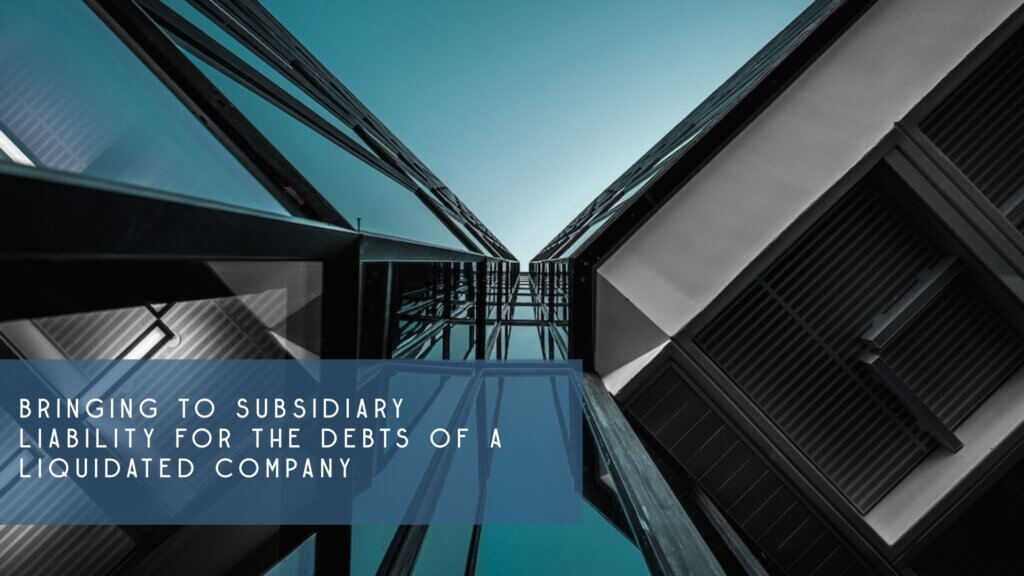Bringing to subsidiary liability for the debts of a liquidated company
As part of the Bank bankruptcy case (No. A40-165246/2022), a number of persons controlling the debtor, including the company, were brought to subsidiary liability. The bank received a writ of execution to collect the debt from the company. Subsequently, the company was excluded from the Unified State Register of Legal Entities due to the presence of false information in the register. The bankruptcy trustee of the Bank demanded, outside the framework of the Bank’s bankruptcy case, to recover the debt on the company’s obligations from the general director and founder of the company as a subsidiary liability.
The court of first instance, with which the appeal and cassation agreed, rejected the claim of the Bank manager. The courts pointed out that the manager had not proven the circumstances indicating that the head of the company had committed any actions (including dishonest and unreasonable ones) that caused the non-repayment of the debt. According to the courts, the mere exclusion of a company from the Unified State Register of Legal Entities as a result of actions (inaction) that led to such exclusion (lack of reporting, settlements for a long time) is not sufficient to bring about subsidiary liability.
The Supreme Court, having considered the cassation appeal of the Bank manager and sending the case for a new consideration, did not agree with this approach and noted the following. Creditors demanding that a person controlling the debtor who does not disclose the documents of a business company be brought to subsidiary liability must and sufficiently prove the elements included in the corresponding presumption, in particular: the presence and size of outstanding claims against the debtor; status of the controlling debtor of the person; his duty to store documents of the business company; absence (distortion) of these documents.
The presumption is rebuttable and otherwise can be proven by the person held vicariously liable. This person must justify why the creditors’ evidence cannot be accepted in support of their arguments by disclosing their documents and providing explanations as to how the business activities were actually carried out and what caused the debtor’s insolvency, what are the reasons for not providing documents and how valid are they, etc.
The presumption provided for in subparagraph 2 of paragraph 2 of Article 61.11 of the bankruptcy law is also applicable in a situation where a claim to bring a controlling person to subsidiary liability is filed by a creditor outside the framework of a bankruptcy case – in the event of exclusion of a legal entity from the register as inactive (“abandoned business”). Otherwise, it would create inequality in the rights of creditors depending on the behavior of controlling persons and would lead to such persons receiving an unjustified advantage only due to the fact that they avoided the bankruptcy procedure of controlled persons, the Economic College emphasized.
In any case, when considering claims for bringing to subsidiary liability, the burden of proof should be distributed by the court, taking into account the need to equalize the opportunities to prove legally significant circumstances of the case, bearing in mind that the creditor, as a rule, does not have access to information about the debtor’s economic activities, and Persons controlling the debtor, on the contrary, have such access and can actually limit it at their discretion.
The court has the right to proceed from the assumption that the guilty actions (inaction) of the controlling persons led to the impossibility of fulfilling obligations to the creditor if it establishes bad faith in the behavior of the controlling persons in the process, for example, when the controlling persons refuse or evade to present to the court evidence characterizing the economic activities of the debtor, from giving explanations or their obvious incompleteness, and unless otherwise follows from the circumstances of the case.
Thus, it was the behavior of the manager that led to the impossibility of fully verifying the plaintiff’s arguments about the reasons why the company did not make settlements with the plaintiff before being excluded from the Unified State Register of Legal Entities, and therefore the impossibility of settlements with the creditor due to the fault of the controlling person is presumed, and the courts’ conclusion about the absence of grounds to satisfy the claim cannot be recognized as legitimate.